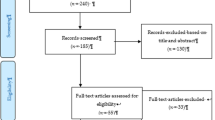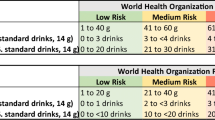Abstract
Despite recent increasing support for the brain disease model (BDM) of alcohol and drug addiction, the extent to which the model may clinically impact addiction treatment and client behaviour remains unclear. This qualitative study explored the views of community-based clinicians in Australia and examined: (i) whether Australian community-based clinicians support the BDM of addiction; (ii) their attitudes on the impact the model may have on clinical treatment; and (iii) their views on how framing addiction as a brain disease may impact addicted clients’ behaviour. Six Australian community-based clinicians participated in semi-structured in-depth interviews that were analysed using thematic analysis. Whilst the BDM was not fully supported by this purposive sample of Australian community-based clinicians, there was acceptance that addiction neuroscience formed a key part of a wider addiction framework. Participants believed the BDM ignored key social, psychological and environmental factors important for successful treatment. The BDM was seen as potentially irrelevant for certain client types (e.g., where housing or financial concerns were of high priority), however the model was believed to integrate with particular therapies (e.g., mindfulness or cognitive-behaviour therapy). Participants believed that for clients viewing their addiction in terms of a brain disease, there were potential positive (increased insight and decreased stigma) and negative (increased stigma and sense of helplessness, reduced personal responsibility) impacts on client behaviour. Implications for addiction treatment practice and public health policy are discussed.
Similar content being viewed by others
References
Leshner, A.I. 1997. Addiction is a brain disease, and it matters. (Cover story). Science 278: 45–47.
McLellan, A.T., D.C. Lewis, C.P. O’Brien, and H.D. Kleber. 2000. Drug dependence, a chronic medical illness. JAMA: Journal of the American Medical Association 284: 1689.
Volkow, N.D. 2005. Editorial: what do we know about drug addiction? The American Journal of Psychiatry 162: 1401–1402.
National Institute on Drug Abuse. 2001. Scientific conference focuses on ecstasy (MDMA): International experts meet to discuss the latest research and emerging trends [Press release]. http://archives.drugabuse.gov/newsroom/01/NR7-19.html. Accessed 30 Mar 2014.
American Society of Addiction Medicine. 2011. Public policy statement: definition of addiction. http://www.asam.org/for-the-public/definition-of-addiction. Accessed 6 Apr 2014.
Carter, A., W. Hall, B. Capps, and M. Daglish. 2009. Neurobiological research on addiction: Review of the scientific, public health and social policy implications for Australia. Sydney: Ministerial Council on Drugs. http://www.nationaldrugstrategy.gov.au/internet/drugstrategy/Publishing.nsf/content/neu-res-add. Accessed 20 Mar 2014.
Verdejo-García, A., D.I. Lubman, K. Roffel, R. Vilar-López, E. Bora, T. MacKenzie, and M. Yücel. 2013. Cingulate biochemistry in heroin users on substitution pharmacotherapy. Australian and New Zealand Journal of Psychiatry 47: 244–249.
Baker, S.T.E., M. Yücel, A. Fornito, N.B. Allen, and D.I. Lubman. 2013. A systematic review of diffusion weighted MRI studies of white matter microstructure in adolescent substance users. Neuroscience & Biobehavioral Reviews 37: 1713–1723.
Lorenzetti, V., D.I. Lubman, D. Velakoulis, and M. Yücel. 2010. Pituitary gland volume among heroin users stabilised on substitution pharmacotherapy. Drug and Alcohol Dependence 110: 164–166.
Fry, C.L., and D.Z. Buchman. 2011. Toward a lay descriptive account of identity in addiction neuroethics. In Addiction neuroethics: The ethics of addiction neuroscience research and treatment, ed. A. Carter, W. Hall, and J. Illes, 175–187. San Diego: Elsevier.
Conrad, P. 1992. Medicalization and social control. Annual Review of Sociology 18: 209–232.
Illich, I. 1977. Limits to medicine. Medical nemesis: the expropriation of health. Toronto: Pelican Books.
Courtwright, D.T. 2010. The NIDA brain disease paradigm: history, resistance and spinoffs. BioSocieties 5: 137–147.
Clarke, A.E., J.K. Shim, L. Mamo, J.R. Fosket, and J.R. Fishman. 2003. Biomedicalization: technoscientific transformations of health, illness, and U.S. Biomedicine. American Sociological Review 68: 161–194.
Netherland, J. 2011. We haven’t sliced open anyone’s brain yet: Neuroscience, embodiment and the governance of addiction. In Sociological reflections on the neurosciences (advances in medical sociology), ed. M. Pickersgill and I. Van Keulen, 153–177. Bingley: Emerald Group Publishing Limited.
Rose, N. 2003. Neurochemical selves. Society 41: 46–59.
Carter, A., and W. Hall. 2012. Addiction may not be a compulsive brain disease, but it is more than purposeful medication of untreated psychiatric disorders. AJOB Neuroscience 3: 54–55.
Foucault, M. 1973. The birth of the clinic: An archaeology of medical perception. London: Tavistok.
Abi-Rached, J.M., and N. Rose. 2010. The birth of the neuromolecular gaze. History of the Human Sciences 23: 11–36.
Bell, S., A. Carter, R. Mathews, C. Gartner, J. Lucke, and W. Hall. 2014. Views of addiction neuroscientists and clinicians on the clinical impact of a ‘brain disease model of addiction’. Neuroethics 7: 19–27.
Cunningham, J.A., and J. McCambridge. 2012. Is alcohol dependence best viewed as a chronic relapsing disorder? Addiction 107: 6–12.
Dingel, M.J., R. Hammer, J.E. Ostergren, J.B. McCormick, and B.A. Koenig. 2012. Chronic addiction, compulsion, and the empirical evidence. AJOB Neuroscience 3: 58–59.
Dingel, M.J., K. Karkazis, and B.A. Koenig. 2011. Framing nicotine addiction as a ‘disease of the brain’: social and ethical consequences. Social Science Quarterly (Wiley-Blackwell) 92: 1363–1388.
Pickard, H. 2012. The purpose in chronic addiction. AJOB Neuroscience 3: 40–49.
Buchman, D.Z., W. Skinner, and J. Illes. 2010. Negotiating the relationship between addiction, ethics, and brain science. AJOB Neuroscience 1: 36–45.
Hammer, R., M. Dingel, J. Ostergren, B. Partridge, J. McCormick, and B.A. Koenig. 2013. Addiction: current criticism of the brain disease paradigm. AJOB Neuroscience 4: 27–32.
Lam, D.C.K., P.M. Salkovskis, and H.M.C. Warwick. 2005. An experimental investigation of the impact of biological versus psychological explanations of the cause of “mental illness”. Journal of Mental Health 14: 453–464.
Pescosolido, B.A., J.K. Martin, J.S. Long, T.R. Medina, J.C. Phelan, and B.G. Link. 2010. “A disease like any other”? A decade of change in public reactions to schizophrenia, depression, and alcohol dependence. The American Journal of Psychiatry 167: 1321–1330.
Satel, S.L. 1999. The fallacies of no-fault addiction. The Public Interest 134: 52.
Connolly, K. 2008. Victorian AOD Sector; qualification review report. Melbourne: Turning Point Alcohol and Drug Centre. http://nceta.flinders.edu.au/files/8612/6741/5986/ENNP7%20Connolly%202008.pdf. Accessed 20 February 2014.
National Centre for Education and Training on Addiction. 2014. AOD specialist workers. http://nceta.flinders.edu.au/workforce/who-are-the-aod-workforce/aod-specialist-workers/. Accessed 1 Mar 2014.
Jessiman, W.C. 2013. ‘To be honest, I haven’t even thought about it’ - recruitment in small-scale, qualitative research in primary care. Nurse Researcher 21: 18–23.
Braun, V., and V. Clarke. 2006. Using thematic analysis in psychology. Qualitative Research in Psychology 3: 77–101.
Lincoln, Y.S., and E.G. Guba. 1985. Naturalistic Inquiry. Newbury Park: Sage Publications.
Farmer, R.L. 2009. Neuroscience and social work practice: The missing link. London: Sage Publications.
Egan, M., S.L. Neely-Barnes, and T. Combs-Orme. 2011. Integrating neuroscience knowledge into social work education: a case-based approach. Journal of Social Work Education 47: 269–282.
Montgomery, A. 2013. Toward the integration of neuroscience and clinical social work. Journal of Social Work Practice 27: 333–339.
Straussner, S.A., R.T. Spence, and D.M. Dinitto. 2013. Neurobiology of addictions: Implications for clinical practice. New York: Routledge.
Best, D., E. Day, T. McCarthy, I. Darlington, and K. Pinchbeck. 2008. The hierarchy of needs and care planning in addiction services: what Maslow can tell us about addressing competing priorities? Addiction Research & Theory 16: 305–307.
Daley, D.C. 2013. Family and social aspects of substance use disorders and treatment. Journal of Food And Drug Analysis 21: S73–S76.
Treloar, C., and M. Holt. 2008. Complex vulnerabilities as barriers to treatment for illicit drug users with high prevalence mental health co-morbidities. Mental Health and Substance Use: dual diagnosis 1: 84–95.
Matto, H.C. 2004. Applying an ecological framework to understanding drug addiction and recovery. Journal of Social Work Practice in the Addictions 4: 5–22.
Phelan, J.C. 2002. Genetic bases of mental illness-a cure for stigma? Trends in Neurosciences 25: 430–431.
Goffman, E. 1963. Stigma: Notes on the management of spoiled identity. Englewood Cliffs: Prentice Hall.
Seligman, M.E., S.F. Maier, and J.H. Geer. 1968. Alleviation of learned helplessness in the dog. Journal of Abnormal Psychology 73: 256–262.
Weisberg, D.S., F.C. Keil, J. Goodstein, E. Rawson, and J.R. Gray. 2008. The seductive allure of neuroscience explanations. Journal of Cognitive Neuroscience 20: 470–477.
Department of Health and Ageing. 2011. National Drug Strategy 2010–2015: A framework for action on alcohol, tobacco and other drugs. http://www.nationaldrugstrategy.gov.au/internet/drugstrategy/publishing.nsf/Content/DB4076D49F13309FCA257854007BAF30/$File/nds2015.pdf. Accessed 20 Mar 2014.
World Health Organisation. 2009. Global health risks. Mortality and burden of disease attributable to selected major risks. http://www.who.int/healthinfo/global_burden_disease/GlobalHealthRisks_report_full.pdf. Accessed 1 Feb 2014.
Acknowledgments
We would like to thank the participants for their time and support for this study. Furthermore, we thank Robyn Dwyer for her research support and Adrian Carter for his comments on an earlier draft of this paper.
Compliance with Ethical Standards
ᅟ
Conflict of interest
The authors declare that they have no COIs.
Ethical approval
All study procedures involving human participants were in accordance with the ethical standards of the institutional and/or national research committee and with the 1964 Helsinki declaration and its later amendments or comparable ethical standards. This study was accepted and deemed to meet the requirements of the National Health and Medical Research Council (NHMRC) ‘National Statement on Ethical Conduct in Human Research (2007)’ by the Victoria University Human Research Ethics Committee (Application ID: HRE14-075; Approval Date: 13/05/2014).
Informed consent
Informed consent was obtained from all individual participants included in this study.
Disclosures
This study was supported in part by the Psychology Program at the Victoria University College of Arts, and the Australian Research Council Discovery Project (DP1094144), Addiction, Moral identity, and Moral Agency. The authors declare that they have no conflict of interest.
Author information
Authors and Affiliations
Corresponding author
Rights and permissions
About this article
Cite this article
Barnett, A.I., Fry, C.L. The Clinical Impact of the Brain Disease Model of Alcohol and Drug Addiction: Exploring the Attitudes of Community-Based AOD Clinicians in Australia. Neuroethics 8, 271–282 (2015). https://doi.org/10.1007/s12152-015-9236-5
Received:
Accepted:
Published:
Issue Date:
DOI: https://doi.org/10.1007/s12152-015-9236-5




